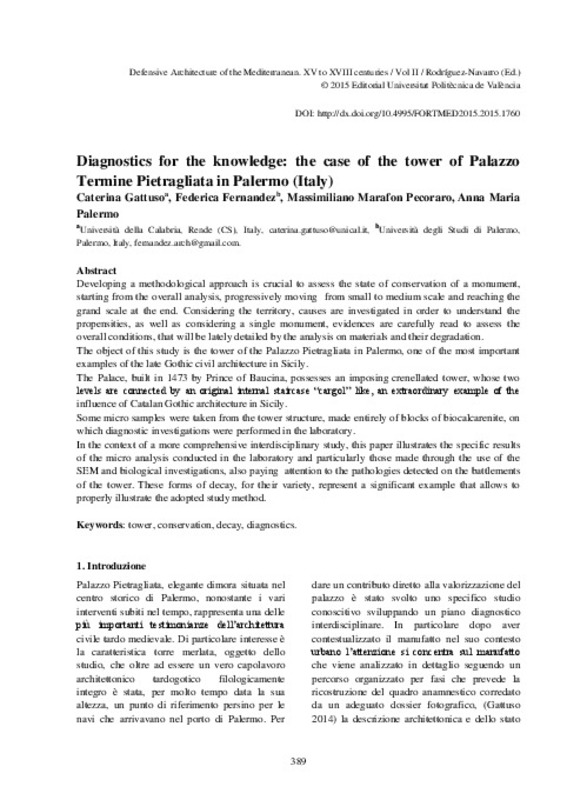JavaScript is disabled for your browser. Some features of this site may not work without it.
Buscar en RiuNet
Listar
Mi cuenta
Estadísticas
Ayuda RiuNet
Admin. UPV
Diagnostics for the knowledge: the case of the tower of Palazzo Termine Pietragliata in Palermo (Italy)
Mostrar el registro sencillo del ítem
Ficheros en el ítem
| dc.contributor.author | Gattuso, Caterina
|
es_ES |
| dc.contributor.author | Fernandez, Federica
|
es_ES |
| dc.contributor.author | Pecoraro, Massimiliano Marafon
|
es_ES |
| dc.contributor.author | Palermo, Anna Maria
|
es_ES |
| dc.coverage.spatial | east=13.36214303970337; north=38.11843649333283; name=Castellammare, Palermo PA, Itàlia | |
| dc.date.accessioned | 2018-01-24T10:48:37Z | |
| dc.date.available | 2018-01-24T10:48:37Z | |
| dc.date.issued | 2015-10-16 | |
| dc.identifier.isbn | 9788490483770 | |
| dc.identifier.uri | http://hdl.handle.net/10251/95440 | |
| dc.description.abstract | [EN] Developing a methodological approach is crucial to assess the state of conservation of a monument, starting from the overall analysis, progressively moving from small to medium scale and reaching the grand scale at the end. Considering the territory, causes are investigated in order to understand the propensities, as well as considering a single monument, evidences are carefully read to assess the overall conditions, that will be lately detailed by the analysis on materials and their degradation. The object of this study is the tower of the Palazzo Pietragliata in Palermo, one of the most important examples of the late Gothic civil architecture in Sicily. The Palace, built in 1473 by Prince of Baucina, possesses an imposing crenellated tower, whose two levels are connected by an original internal staircase “cargol” like, an extraordinary example of the influence of Catalan Gothic architecture in Sicily. Some micro samples were taken from the tower structure, made entirely of blocks of biocalcarenite, on which diagnostic investigations were performed in the laboratory. In the context of a more comprehensive interdisciplinary study, this paper illustrates the specific results of the micro analysis conducted in the laboratory and particularly those made through the use of the SEM and biological investigations, also paying attention to the pathologies detected on the battlements of the tower. These forms of decay, for their variety, represent a significant example that allows to properly illustrate the adopted study method. | es_ES |
| dc.format.extent | 8 | es_ES |
| dc.language | Italiano | es_ES |
| dc.publisher | Editorial Universitat Politècnica de València | es_ES |
| dc.relation.ispartof | Defensive architecture of the mediterranean: XV to XVIII centuries. Vol. I | es_ES |
| dc.rights | Reconocimiento - No comercial - Sin obra derivada (by-nc-nd) | es_ES |
| dc.subject | Fortifications | es_ES |
| dc.subject | Mediterranean | es_ES |
| dc.subject | Modern age | es_ES |
| dc.subject | Built Heritage | es_ES |
| dc.subject | Tower | es_ES |
| dc.subject | Conservation | es_ES |
| dc.subject | Diagnostics | es_ES |
| dc.title | Diagnostics for the knowledge: the case of the tower of Palazzo Termine Pietragliata in Palermo (Italy) | es_ES |
| dc.type | Capítulo de libro | es_ES |
| dc.type | Comunicación en congreso | es_ES |
| dc.identifier.doi | 10.4995/FORTMED2015.2015.1760 | |
| dc.rights.accessRights | Abierto | es_ES |
| dc.description.bibliographicCitation | Gattuso, C.; Fernandez, F.; Pecoraro, MM.; Palermo, AM. (2015). Diagnostics for the knowledge: the case of the tower of Palazzo Termine Pietragliata in Palermo (Italy). En Defensive architecture of the mediterranean: XV to XVIII centuries. Vol. I. Editorial Universitat Politècnica de València. 389-396. https://doi.org/10.4995/FORTMED2015.2015.1760 | es_ES |
| dc.description.accrualMethod | OCS | es_ES |
| dc.relation.conferencename | FORTMED2015 - International Conference on Modern Age Fortifications of the Western Mediterranean coast | es_ES |
| dc.relation.conferencedate | October 15-17,2015 | es_ES |
| dc.relation.conferenceplace | Valencia, Spain | es_ES |
| dc.relation.publisherversion | http://ocs.editorial.upv.es/index.php/FORTMED/FORTMED2015/paper/view/1760 | es_ES |
| dc.description.upvformatpinicio | 389 | es_ES |
| dc.description.upvformatpfin | 396 | es_ES |
| dc.type.version | info:eu-repo/semantics/publishedVersion | es_ES |
| dc.relation.pasarela | OCS\1760 | es_ES |








